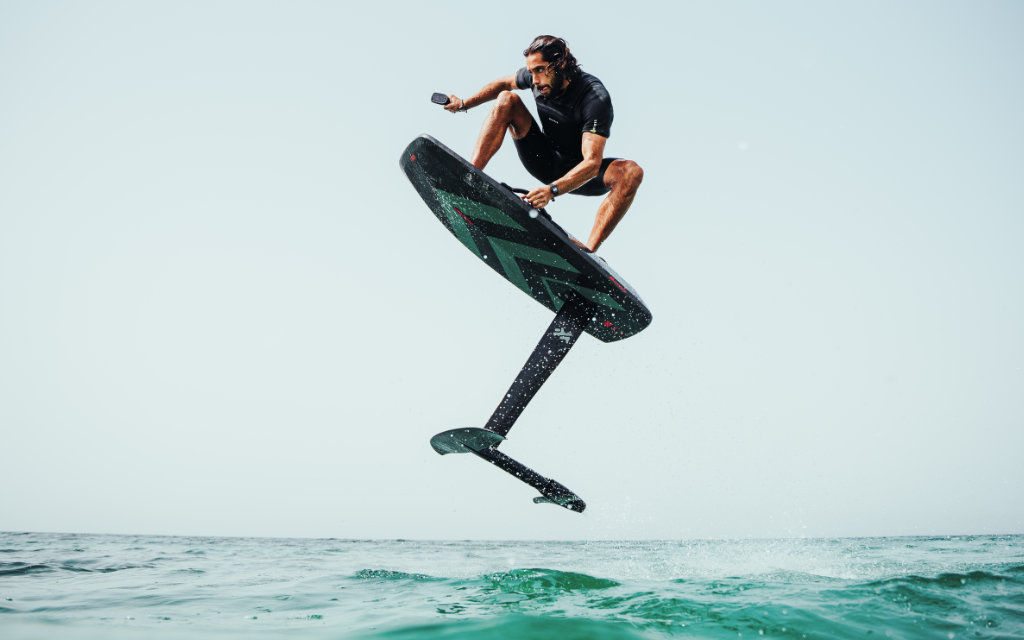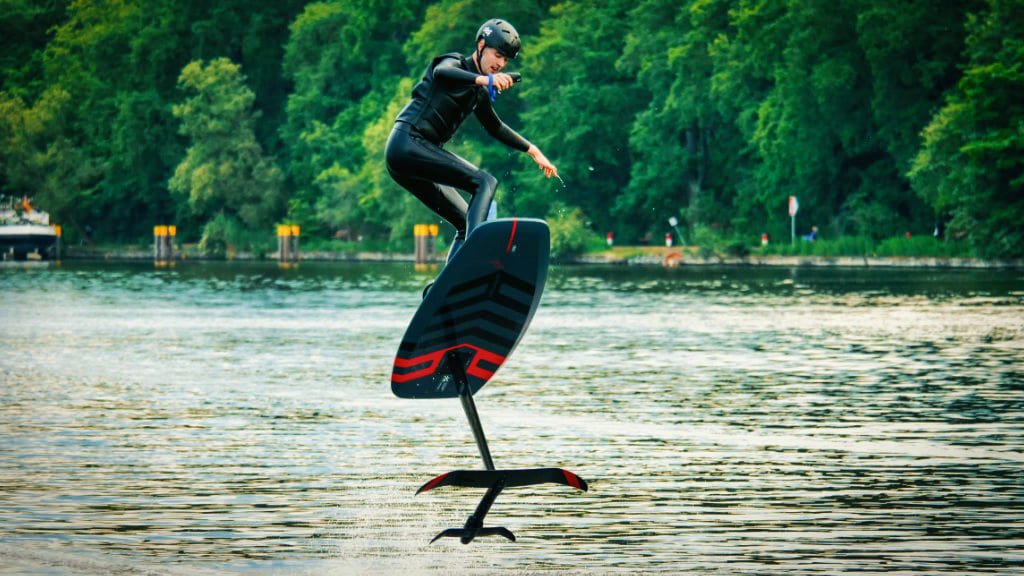How do you perform an ollie or air on an eFoil? Learn how to perform eFoil jumps safely and consistently. Setup recommendations, clear steps, landing technique, error correction, conditions, FAQ.
Are you an experienced eFoiler and want to learn how to jump with an eFoil? Let's get started...
Why this eFoil jump guide?
Goal: clean, repeatable eFoil jumps. Basis: practical tips collected from various professional riders (kite/wing/eFoil) and real learning mistakes. Safety is our top priority, so we start with the basics.
Using the wrong equipment and/or configuration for your first jump attempts can easily result in injury. Incidentally, we only use jet propulsion for our jumps to avoid contact with a propeller.
In the pictures and videos, you can see the Audi e-tron foils from Aerofoils, but Lift Foils, Fliteboard, and others also offer jets.
Here is a short video from our E-SURFER YouTube channel on the topic of “How to jump with an eFoil”:
As you can see in the video, 180s and even 360s are possible.
Setup for your first eFoil jumps
When jumping with an eFoil for the first time, it's important to make sure you have the right setup.
Board size:
The safest way to start is with a larger board around 100 liters. Although larger boards don't get you as high in the air, they do make your first attempts land softer.
Later on, you can then switch to smaller models. We prefer the Audi Performance, Aerofoils Competition, or the Lift5 4'9 Sport. Both with jet for safety reasons.
Board material
Brand manufacturers such as Aerofoils and Lift Foils rely on carbon boards for good reason. Carbon is light and reactive. Fiberglass is heavier. Inflatable eFoils are too blunt and slow down on the water surface.
Mast length
Longer masts around 80 cm (preferably made of carbon) increase the leverage and thus enable higher jumps.
Wings
The standard wings from brand manufacturers (200 in² (~1290 cm²) or 175 in² (~1130 cm²)) are well suited for your first jumps.
Smaller wings are more sporty, but require very good timing. Larger wings take off earlier, but slow down too much on landing.
Straps / foot straps
No foot straps for beginners. This offers you more safety and better technique, as your feet are flat and the pressure is distributed across the entire pad.
Those who jump better later on can achieve higher eFoil jumps with foot straps.
Protection
Helmets and impact vests are mandatory when jumping with the eFoil for the first time. If you do not have a jet drive, a prop guard is recommended.

How to jump: Safety rules
You need an open area. Never ride or jump in swimming areas. You need enough depth for the mast + reserve. At least 125 cm water depth.
Look ahead. The emergency routine must be clear:
- If you fall off the board
- Protect yourself from the foil
- Release the trigger: the propeller stops (better with a jet or at least a prop guard)
No jumping without solid basic skills: Maintain height, turn on both edges, control throttle smoothly.
Always wear a helmet and vest!
Core idea of the jump
The motor helps, but the pop (momentum) comes from your legs and the board angle.
Sequence: start → preload → slight edge → pop + short trigger boost → compact in the air → land flat → soft approach.
How to jump with the eFoil: step by step
1) Start
Moderate speed. Choose an area that you can freely exit after landing. Look where you want to land.
2) Preload
Bend your knees. Hips low. Upper body compact. Center of gravity centered over the board. Feet flat. No pressure on the toes.
3) Set the edge
Minimal edging. 2–5 degrees is enough. Goal: to “load” the wing, not shoot it sideways.
4) Initiate pop
Lean back briefly to raise the nose slightly. Extend your legs explosively. That's the pop. At the same time, give a short trigger impulse. It only takes a moment. The motor is the booster, not the elevator.
5) Body posture in the air
Front knee to chest. This keeps your center of gravity low and centered. Shoulders relaxed. Mast axis neutral. No large tilt angles. Continue to hold the trigger gently. Do not go full throttle to prevent the motor from overheating.
6) Prepare for landing
Look ahead. Level the board. Mast vertical. Pull the trigger slightly just before touchdown to dampen the descent phase.
7) Landing and extending
Land flat. Cushion the impact. Then lean forward slightly and continue smoothly. Stabilize first, then build up speed.
Jumping high vs. jumping far
More height. Slightly more preload, clearer leg pop. Trigger impulse remains short.
More distance. Increase forward speed slightly. Keep the pop flatter. Landing even flatter.

Conditions: Flat water vs. small waves
Flat water is easier for beginners. Timing remains constant.
Small waves provide height, but require precise timing. Pop just before the wave crest. You don't need a lot of height to learn. You can just let the wing “shoot out” briefly and catch it again immediately.
Footwork and center of gravity
Staying on the board. Problem: front foot slips or “lifts off.” Solution: feet flat, not on toes. Pressure across the entire sole. No sideways jumps. Keep your body above the board's longitudinal axis.
Tall riders. Make yourself small. Knees and shoulders over the center of the board. The taller you are, the more likely your body is to tip off the board. Compression prevents this.
Weight transfer. When jumping, lean back briefly, then lean forward slightly again immediately upon landing. This keeps the drive in the water and the board starts moving immediately.
Trigger management
Standard rule. Do not release in the air. A gently held trigger prevents the board from “stopping” when landing.
Exception: emergency. Feeling of loss of control or danger? Release immediately. Motor stops. Safety comes first.
Typical mistakes
- Too long an impulse. Pulling in the air, nose drifts forward, hard landing. Solution: shorten the impulse.
- No impulse. Only pulling without motor boost. Solution: short nudge when popping.
- Full throttle after landing. Setup “sticks.” Solution: dampen first, then accelerate.
Common mistakes and direct fixes
1) Nose dive when landing
Cause: looking down. Board too steep. Throttle too late.
Fix: Look ahead. Board flat. Pull trigger shortly before touchdown.
2) Tilting sideways
Cause: Too much edge angle when jumping.
Fix: Pop from almost neutral edge. Carve smaller.
3) “Getting off” the board in the air
Cause: Feet not flat. Body not over the longitudinal axis.
Fix: Feet flat. Upper body centered. Front knee up.
4) Not continuing after landing
Cause: Trigger released.
Fix: Hold gently in the air. Accelerate on landing. Both for jet and propeller.
5) Overloading equipment
Cause: Steep landing. Full throttle in the air.
Fix: Land flat. Short impulses. No full throttle in flight.

Speed tips
Ride at a moderate speed. Learn at medium speed. Do not start at high speed.
Only increase your speed once your timing and landings are stable. Focus on how you feel, not on the numbers on the remote control!
Practical checklist before each jump
- Spot clear and deep enough
- Look towards the landing zone
- Preload
- Lightly edge
- Pop + short trigger impulse
- Pull up front knee
- Flatten board for landing
- Pull trigger just before touchdown
- Follow through, extend, stabilize
How to jump with the eFoil - FAQ
Do I need a wave to learn?
No. Flat water is easier because the timing is consistent. Small “ramps” help later on.
Are foot straps necessary?
No. Strapless is safer in the beginning and teaches technique. Later on, use foot straps.
What is more important: throttle or pop?
Pop. Throttle is a short booster. Technique is decisive.
When should I release the trigger?
Only in an emergency. Safety first. The standard is to hold gently and accelerate on landing.
What board size helps with landing?
For the first few times, a 100-liter board - landings become more forgiving. Later, smaller boards.


 28 min read
28 min read